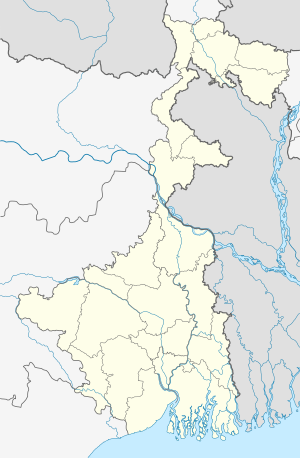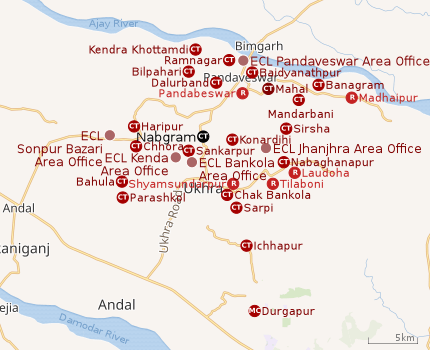Nabgram
Nabgram is a census town in the Pandabeswar CD block in the Durgapur subdivision of the Paschim Bardhaman district in the Indian state of West Bengal.
Nabgram | |
|---|---|
Census Town | |
 Nabgram Location in West Bengal, India  Nabgram Nabgram (India) | |
| Coordinates: 23.678565°N 87.244724°E | |
| Country | |
| State | West Bengal |
| District | Paschim Bardhaman |
| Area | |
| • Total | 4.51 km2 (1.74 sq mi) |
| Population (2011) | |
| • Total | 4,626 |
| • Density | 1,000/km2 (2,700/sq mi) |
| Languages* | |
| • Official | Bengali, Hindi, English |
| Time zone | UTC+5:30 (IST) |
| PIN | 713363 |
| Telephone/STD code | 0341 |
| Vehicle registration | WB |
| Lok Sabha constituency | Asansol |
| Vidhan Sabha constituency | Pandaveswar |
| Website | paschimbardhaman |
Geography
 |
| Cities, towns and ECL Areas in the northern portion of Durgapur subdivision in Paschim Bardhaman district MC: Municipal Corporation, CT: census town, R: rural administrative centre Owing to space constraints in the small map, the actual locations in a larger map may vary slightly |
Location
Nabgram is located at 23°40′43″N 87°14′41″E.
The Asansol-Durgapur region is composed of undulating laterite soil. This area lies between two mighty rivers – the Damodar and the Ajay. They flow almost parallel to each other in the region – the average distance between the two rivers is around 30 km. For ages the area was heavily forested and infested with plunderers and marauders. The discovery of coal led to industrialisation of the area and most of the forests have been cleared.[1]
Konardihi, Nabgram, Chak Bankola, Sankarpur, Haripur, Bahula, Chhora and Parashkol form a cluster of census towns in the southern portion of Pandabeswar CD block.[2]
Urbanisation
According to the 2011 census, 79.22% of the population of the Durgapur subdivision was urban and 20.78% was rural.The Durgapur subdivision has 1 municipal corporation at Durgapur and 38 (+1 partly) census towns (partly presented in the map alongside; all places marked on the map are linked in the full-screen map).[3]
Demographics
According to the 2011 Census of India, Nabgram had a total population of 4,626, of which 2,431 (53%) were males and 2,195 (47%) were females. Population in the age range 0-6 years was 609. The total number of literate persons in Nabgram was 3,032 (75.48% of the population over 6 years).[4]
*For language details see Pandabeswar (community development block)#Language and religion
As of 2001 India census,[5] Nabgram had a population of 4,643. Males constitute 54% of the population and females 46%. Nabgram has an average literacy rate of 58%, lower than the national average of 59.5%: male literacy is 68%, and female literacy is 46%. In Nabgram, 11% of the population is under 6 years of age.
Infrastructure
According to the District Census Handbook 2011, Bardhaman, Nabgram covered an area of 4.51 km2. Among the civic amenities, the protected water-supply involved service reservoir, tap water from treated sources, uncovered wells. It had 382 domestic electric connections. Among the medical facilities it had were 1 dispensary/ health centre. Among the educational facilities it had were 2 primary schools, other school facilities at Ukhra 3 km away. Among the social, recreational and cultural facilities it had was 1 public library. Among the important commodities it produced were coal, paddy, vegetables.[6]
Economy
As per the ECL website telephone numbers, operational collieries in the Bankola Area of Eastern Coalfields in 2018 are: Bankola Colliery, Khandra Colliery, Kumardih A Colliery, Kumardih B Colliery, Moira Colliery, Nakrakonda Colliery, Shankarpur Colliery, Shyamsundarpur Colliery and Tilaboni Colliery.[7]
Education
Nabgram has three primary schools.[8]
References
- Chattopadhyay, Akkori, Bardhaman Jelar Itihas O Lok Sanskriti (History and Folk lore of Bardhaman District.), (in Bengali), Vol I, pp 14-15, Radical Impression. ISBN 81-85459-36-3
- "District Census Handbook Bardhaman, Series 20, Part XII A, Census of India 2011" (PDF). Map of Pandabeswar CD Block, page 243. Directorate of Census Operations, West Bengal. Retrieved 7 September 2018.
- "District Statistical Handbook 2014 Burdwan". Table 2.2, 2.4(a). Department of Statistics and Programme Implementation, Government of West Bengal. Retrieved 15 September 2018.
- "2011 Census – Primary Census Abstract Data Tables". West Bengal – District-wise. Registrar General and Census Commissioner, India. Retrieved 20 February 2017.
- "Census of India 2001: Data from the 2001 Census, including cities, villages and towns (Provisional)". Census Commission of India. Archived from the original on 16 June 2004. Retrieved 1 November 2008.
- "District Census Handbook Barddhaman, Census of India 2011, Series 20, Part XII A" (PDF). Section II Town Directory, Pages 1179-1210; Statement I: Status and Growth History, Page 1179; Statement II: Physical Aspects and Location of Towns, Page 1188; Statement III: Civic and other Amenities, Page 1191; Statement IV: Medical Facilities, Page 1196; Statement V: Educational, Recreational and Cultural Facilities, Page 1200; Statement VI:Industry and Banking, Page 1209:. Directorate of census Operations V, West Bengal. Retrieved 14 May 2020.CS1 maint: extra punctuation (link)
- "Area wise Closed User Group (CUG) Telephone Numbers" (PDF). Bankola Area. Eastern Coalfields Limited. Retrieved 16 August 2018.
- 7th All-India School Education Survey 2003 Archived 2007-09-27 at the Wayback Machine